Joris Voorn: “I could probably throw away 90% of my gear and still make the music I do today”
We head into the studio with the Dutch techno titan

Born in Tilburg, Netherlands, Joris Voorn was raised in a musical family and learned to play violin and guitar before becoming obsessed by the art of DJing and the subversive sounds of techno.
His first production, Muted Trax, swiftly became an underground hit, convincing Voorn to follow his passion and ditch a career in interior architecture.
Inspired by Richie Hawtin’s DE9 series, Voorn released the breakthrough Balance 014 mix compilation in 2009 and achieved fame with his Dusty House Room EPs. He subsequently released a string of critically acclaimed artist albums, founded two labels and became an established DJ on the club and festival circuit.
With a new album, \\\\ (AKA Four) set to be released on Friday 15 November, we caught up with to Joris in his Amsterdam studio.
To this day, I still believe the '90s was the most amazing time for dance and electronic music.
How important was your early acquisition of the MC-303 Groovebox?
“That’s where it all started for me. I was reading a book about dance music because I was really intrigued by how it was made and who was making it and read that I needed to buy a Roland TB-303. This was in 1996, ten years after they’d stopped producing them, so I went to the shop and the guy said we have this other 303 - the groovebox.
"It didn’t have the sound I was looking for because I loved Josh Wink’s Higher State of Consciousness and all those acid records, but I was completely consumed by trying to learn the machine and how MIDI worked. If I’d bought a synthesizer, I wouldn’t have learned as much. The groovebox may have sounded crappy but it was a one-stop shop for making that kind of music.”
Get the MusicRadar Newsletter
Want all the hottest music and gear news, reviews, deals, features and more, direct to your inbox? Sign up here.
Was the Juno-106 another important step in your gear journey?
“A couple of years after I bought the groovebox I moved to Rotterdam and met someone who had all the Roland gear. I asked him what I should buy and he told me to start with the Juno-106.
“I knew nothing about synthesisers, especially the limitations of an analogue synth, but I bought it and it was the perfect machine to help me write and produce music in a more serious way. It really is so simple to use; just a couple of knobs and no internal effects except for the nice chorus and a very warm and fat sound - sometimes too fat!
“You can get immediate results if you know what you’re after, whereas some synths just give me a bit of a headache. I still use the Juno to this day, although I find that the TAL plugin versions are very close to the original.”
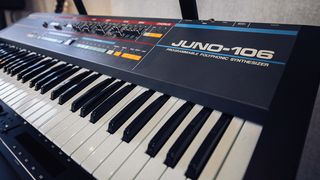
Your music has always sounded very lush and dreamy. Is there a philosophy behind the mood you’re trying to communicate to the listener?
“When I make music, I try to make it from the heart. I still draw inspiration from mid-’90s electronic music. To this day, I still believe it was the most amazing time for dance and electronic music. So much was discovered at that time, from the heyday of Aphex Twin to Detroit and UK techno, and it was all very melodic and lush-sounding, which left a big impression on me.”
For you, melody and atmosphere seem to take prominence over beats and loops…
“That’s true, and it’s something I struggle with sometimes. I like to make music that sounds good in a studio setting, the car or just walking around the city - to create something that touches you in a different way to club grooves. Sometimes I feel that drums can get in the way of the emotion of a track, especially in music that’s produced with very fat drums. To get melodies to work with a very rigid bass drum can often kill the vibe; it’s a fine line.”
Creatively speaking, are beats an afterthought?
“I definitely don’t begin with the bass drums. Sometimes I think a percussion loop or some sort of drum programming could be the basis, but I never start with a kick drum. Of course there are producers who do that, which I can understand because you can build something around it easily.”
Perhaps surprisingly, you cite the director David Lynch as an influence. Is that where your music draws inspiration from in terms of atmosphere?
“David Lynch is definitely a very old influence [laughs], but as a filmmaker I think he, along with many other directors, has had a big impact on my artistic and creative vision. I don’t listen to soundtracks a lot - I find them quite boring, but I do enjoy listening to music in movies when they’re done in a creative way. It’s also relatable to when I make an album or mix compilation, as I always feel there’s a narrative I’m trying to follow or set a mood to, and that can also happen within a track.
“It’s hard to elaborate, but instead of just throwing an arpeggio down, I’ll try to use it to create tension over time and layer sounds that accentuate certain movements and bring the music to life - a bit like you might have in a movie sequence. I’ve also been very influenced and intrigued by bands like Future Sound of London, who always had a strong soundtrack vibe to their music.”
Your last album Nobody Knows had a few vocal contributors. Is that something you’ve expanded on with the new album?
“I think vocals are really interesting to work with. There are two tracks on the upcoming album that have vocals - one featuring Karl Hyde of Underworld and another with a UK band called Hælos. I wanted to get some other people in too, but didn’t have the time.”
Is integrating vocals a new experience for you, production-wise?
“I don’t have an awful lot of experience, so I tend to go with what I think sounds good. Sometimes I prefer the music to speak for itself, but vocals definitely bring an extra dimension.
“I’ve actually never been in a studio with vocalists. I’ll send some music over, let them record their parts and rework it. The funny thing about vocals is that when I get them back they really change the music from my perspective and I’ll tend to try to build the production around the sound of the vocal.”
Is it typically a case of stripping away whatever lies beneath?
“That’s one thing, but other elements will inevitably be added or replaced. With Underworld, I had a great vision for the track, and I think the original was still a great idea, but the album version became something completely different, so sometimes a vocal can trigger a very extreme change.
“It’s almost like remixing yourself with the input of someone else. With Hælos, the vocalist made some really great vocal parts with bits coming in here and there, and that changed my perspective and inspired me to work in a different way.”
You were quite an early adopter of Ableton Live, using it to mix tracks as far back as 2005. What did you see in it?
“I remember a friend of mind talking about this programme in 2002. He told me that it automatically loops whatever you put in and you can layer things. I was more into Cubase, so it took a while to switch to Ableton, but I was inspired by Richie Hawtin’s Decks, EFX series and wanted to deconstruct music and reconstruct it again.
“I started using the programme for my live gigs, then recreated those live sessions in the studio. As the sessions were already in Ableton, I eventually decided to finish them in Ableton for future productions.”
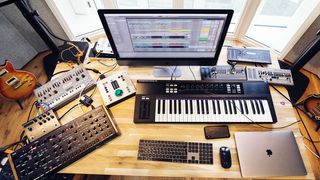
So that’s become your primary DAW to this day?
“For many years I used to export all the stems and remix and re-engineer them in Cubase, but now when I open Cubase I don’t know what to do any more [laughs]. The advantage of taking a project into Cubase is that it looks more like you’re in a studio mix setting, whereas Ableton looks very German - grey, with thin lines, and it doesn’t really look like a production machine.
At first, putting tracks into Cubase gave the music a new perspective and enabled me to work on them in a different way, but I don’t do that any more because I’m so familiar with Ableton. It’s funny how you can adapt to something so quickly.”
Tell us about your studio. It looks very homely, overlooking the canals of Amsterdam…
“I’ve moved around over the past few years. My previous Amsterdam studio was also in Future Music, but after moving around a bit I decided to buy somewhere closer to home and turn it into a new studio.
It’s been very professionally designed by one of the best studio designers and builders in the Netherlands, with very big windows overlooking the canals, and it’s a really nice studio to come to and be inspired by.”
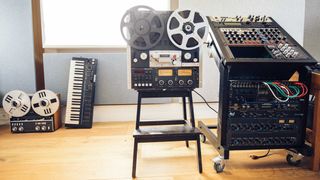
We noticed you have a reel-to-reel tape recorder. Is that an integral part of your outboard setup?
“It’s not for show. I bought it this year because I was really intrigued by what it could do. I’ve been using Universal Audio tape plugins on the master bus for quite a long time, either on percussion or more creatively, but I wanted to see what it would be like to work with the real thing.
“I studied which one to get and eventually went for the Studer A810, which is an amazing machine, but it didn’t give me the glue that people suggested. It has a very subtle effect that doesn’t necessarily work on dance music as well as I would have liked, but I’m going to experiment with it a bit more.
“These machines were actually designed to be neutral rather than give a tape effect. If anything, they were trying to avoid tape hiss, wow and flutter - all the things that people love about tape these days.”
Do you feel the digitisation of music has led people to add these sound artefacts?
“There are so many plugins that try to emulate analogue gear, but in the end it’s still digital stuff with a vintage-looking interface. I think there’s a bit of trickery involved that people buy into, even if they do sometimes sound cool, but I must admit the tape emulations from Universal Audio sound amazing and you can do creative things with them that you can’t do with other plugins.”
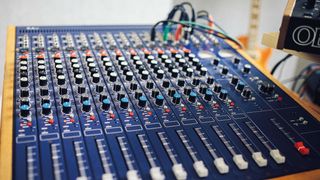
You have a small mixing desk, too, which further indicates you’re looking to add analogue processing into the chain…
“It’s a TAL audio tube mixer, which sounds great, but with a lot of the music I make it sometimes makes things sound too soft. Going back to the question you had about drums, sometimes I’m trying to make them sound quite delicate, but at the same time I want them to punch through in a club environment, and using a mixer like this makes them sound softer than I’d intended. It rounds off the transience, which is great for some styles of music, but not all the time.
“In that sense, I’ve recorded some live tracks with a 909 and synths running through the mixer, but haven’t used it much for summing.”
In terms of synth hardware, tell us about the OB-6…
“Dave Smith collaborated with Tom Oberheim to create this newly updated version and it’s an amazing synthesizer that sounds fantastic.
“I bought a Prophet-6 a few years ago and this synthesiser is very close to that. I used it on quite a lot of tracks on the new album because it has a bit of a warmer and wider sound than the Prophet. It’s lush, but also aggressive - a very musical instrument.”
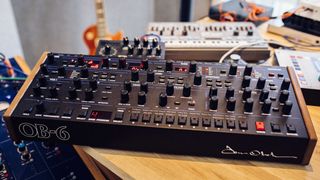
What other hardware synths are important to your music-making process?
“At the moment I’m using the OB-6 a lot, the Prophet-6 on quite a few tracks, and two years ago I picked up a very old Roland MC-202 in Japan. It’s basically an SH-101, except I’m not using the internal sequencer. I’ve also used the Roland Boutique 101 on quite a lot of my tracks, which is basically just a plugin-in-a-box. I do have an original 101, but one of the knob faders doesn’t work so I can’t use it to its full extent.
“But whether using the original or the plugin version, almost all of my tracks feature the 101 either as an effect, arpeggio or bassline. I think it all goes back to the same principle as the Juno-106; it’s such an archetypal synthesiser - a bread and butter musical tool.”
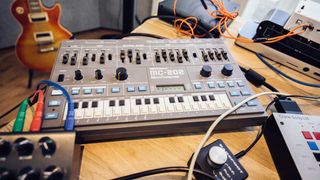
Do you get your beats from hardware or devise them in the box?
“For bass drums I use the Kick 2 bass drum plugin from Sonic Academy because it allows you to draw your bass drums in very creative ways. Software still plays a big role in my process.
“Over the past few years I’ve been making a lot of music on the road, which obviously needs to be done using software. I mentioned the TAL Juno-106 and 101 plugins, but I also really enjoy using Omnisphere. It’s so old, but still sounds really amazing - it would be my desert island plugin for sure. You can do pretty much anything with it and I think it’s one of the best soft synths ever made.”
When you bring the software-based tracks back to the studio, do they sound a lot different to those conceived using hardware?
“Yes, but a lot of that’s down to the fact they’ve been conceived on headphones, which gives you a different sound palette. Those tracks can sound quite boxy sometimes, and I might need to replace or reposition sounds in the mix, so it’s unlikely I’ll finish a track on headphones.”
Is sidechain compression a technique you use?
“Ableton was one of the first and maybe best programmes to use sidechaining in a very easy way. It took a long time for Cubase to get close to featuring it, but there was a complicated workaround.
“What I usually do is duck the bassline, and sometimes a few synthesizers and pads, but I’ll try not to make it audible because it’s not a sound that I’m really after. Sidechaining can really help you to make things sound a bit more open, as long as you don’t push it too hard.”
How does it play a role in your process?
“I think its main purpose is to free space for other instruments in the mix and glue things together. It’s a compressor, basically, driven from the bass drum. So when the kick comes in, if you add sidechain you’re taking away some level of another instrument.
“For example, it will push down the bassline and glue everything together to unify the sound in a nice way, but if you do it too much you get this sucking effect. It can also work really well if you sidechain some effects or pads to give a bass drum the power it needs.”
I also really enjoy using Omnisphere. It’s so old, but still sounds really amazing - it would be my desert island plugin for sure.
Are there any other production techniques you would recommend?
“One of the things I’m always trying to do is EQ things in the right way. I use the FabFilter Pro-Q 3 because it’s an amazing piece of software that allows you to really dig into a sound and remove some of the elements you don’t really want. For example, if you have too much bass that doesn’t really add anything musical to the mix, it can be easily taken out or you can remove frequencies that are cluttering up space or standing out too much.
“Sometimes you just want to accentuate frequencies, so I’ll often try to tune or EQ the bass drum in a way that it works in the mix really well. A 909 kick might have too much punch around the 100-200Hz mark, so I’ll try to take that down to the 50-60Hz range to balance the kick with other elements of the mix.”
Any tips for mixing itself?
“When I’m working with a percussion loop, or maybe a whole percussion channel, there’s a couple of plugins that are really good for removing any transience or sustain that’s going on for too long, or maybe you might have too much reverb on a snare or hi-hat. In that case, I’ll often use the Sonnox Oxford Envolution plugin, which can maintain the musicality of a groove by surgically removing those parameters. You could also use the plugin to add transience if that’s what you’re after.
“I also find that the multiband dynamic presets in Ableton, such as Reduce Ambience, really do what they say when it comes to reducing a lot of the reverb you might find on a sample. If you tweak the settings a bit you can really mould things.”
Dynamic range is obviously an aspect of mixing that you pay close attention to. Where do you stand on compression?
“Louder is never better; that’s an urban myth and I know this from my experience as a DJ. I play with Traktor, which is great because it puts all the tracks on the same level. If you play on CDJs, you have to manually adapt the gain all the time and it’s really annoying when one track is louder than another. In Traktor, my computer does most of that work for me. OK, sometimes it doesn’t get it right, but when I record a mix and listen back and look at the waveforms, the best-sounding tracks usually have the higher waveforms and the ones that look really squeezed sound just as loud but they’re worse because they lack dynamic range.”
It seems these limiting devices are becoming increasingly widespread…
“That’s true. The same thing goes for Spotify and other streaming services. Nowadays they put everything at the same level so there’s no point making your tracks sound extremely loud because they’ll just play it at the same level as a singer-songwriter track that’s typically mastered at a relatively low level.
“I always used to put a compressor on my master bus, but I don’t do that anymore because it takes away from the musicality, and you can use sidechaining to get the same effect anyway.”
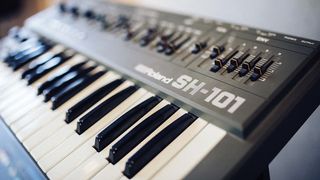
Do you feel pressured to keep up with the latest evolutions in the software or hardware realms?
“The problem is there’s always a new instrument or plugin that presents something you didn’t know you needed. The great thing about electronic music is that machines are designed by people who think outside of the box.
There’s an amazing documentary on YouTube about Roland. If you look at the history of the designer who made the 303, 808 and 909, it’s unbelievable how creative he was and the influence he had on electronic music. At the time, everyone thought these creations were useless, yet they turned out to be the blueprint for house and techno. Today, people are still bringing completely new technologies to the table even though it’s become a lot more complicated to achieve, but I’m always curious.”
Does modular interest you?
“There’s a lot of stuff happening in the modular world, but it’s something I’m keen to stay away from for my own health [laughs]. It’s easy to get caught up in that and keep buying and buying until you’ve bought a spaceship for your studio that’s impossible to control, but it doesn’t suit my kind of music. I’m more interested in the musical approach rather than the experimental.
“To be honest, I could probably throw away 90% of what I have and still make the music I do today, but sometimes it’s nice to buy a new instrument just because it’s designed a certain way or makes you do things differently. It’s not that you can’t make the same sound with something else - that’s hardly ever the case, it’s rather that new gear might inspire you in some way and you never know where that inspiration might come from.”


Future Music is the number one magazine for today's producers. Packed with technique and technology we'll help you make great new music. All-access artist interviews, in-depth gear reviews, essential production tutorials and much more. Every marvellous monthly edition features reliable reviews of the latest and greatest hardware and software technology and techniques, unparalleled advice, in-depth interviews, sensational free samples and so much more to improve the experience and outcome of your music-making.

“If it wasn’t for that song, that would have been the end of the band”: How one track’s sudden gear-switch led Coldplay into their imperial phase

“He was like, ‘You’ve got it all wrong, man": Mumford & Sons reveal what Neil Young told them about the way they were approaching their live shows and album recordings









